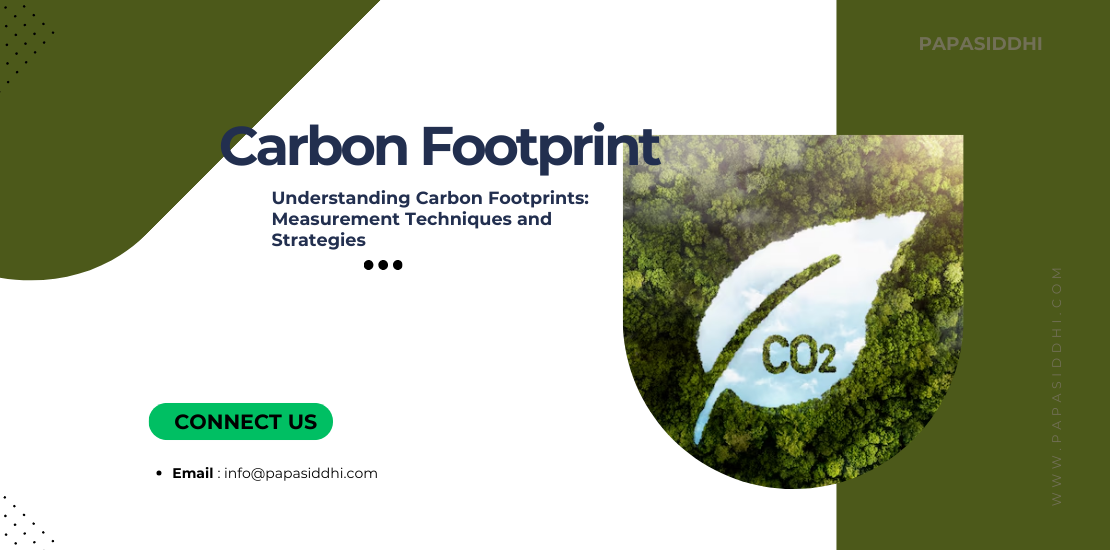- May 8, 2024
- Posted by: papasiddhi
- Category: Innovation

Introduction :
In the urgent quest to mitigate climate change, understanding and reducing carbon footprints have become paramount. A carbon footprint represents the total amount of greenhouse gases, primarily carbon dioxide (CO2), emitted directly or indirectly by human activities. By quantifying these emissions, individuals, businesses, and policymakers can identify areas for improvement and implement strategies to minimize their carbon impact. In this blog, we’ll delve into the measurement techniques used to assess carbon footprints, explore strategies for reducing them.
Measuring Carbon Footprints:
Accurately measuring carbon footprints involves assessing emissions across various sources and activities. Several techniques and methodologies exist for this purpose, each with its own strengths and limitations:
1. Life Cycle Assessment (LCA): LCA is a comprehensive methodology that evaluates the environmental impacts of a product, process, or service throughout its entire life cycle. This includes raw material extraction, production, use, and disposal. LCA considers both direct emissions (e.g., fuel combustion) and indirect emissions (e.g., electricity consumption) to provide a holistic view of carbon footprints.
2. Carbon Accounting Tools: Numerous carbon accounting tools and software platforms are available to streamline the measurement and reporting of carbon footprints. These tools typically rely on standardized emission factors and data inputs to calculate carbon emissions across different sectors and activities. Examples include the Greenhouse Gas Protocol, Carbon Trust Footprint Calculator, and Carbon Footprint Ltd’s Carbon Calculator.
3. Carbon Inventory: For organizations, conducting a carbon inventory involves systematically cataloging and quantifying emissions from various operational activities, such as energy consumption, transportation, and waste generation. This process often requires collecting data from utility bills, fuel receipts, and other sources to estimate emissions accurately.
4. Carbon Footprint Standards: Several international standards and protocols govern the measurement and reporting of carbon footprints, providing guidelines and best practices for organizations and individuals. These standards, such as ISO 14064 and PAS 2050, ensure consistency, transparency, and credibility in carbon footprint assessments.
Strategies for Reducing Carbon Footprints:
Once carbon footprints are measured, the next step is to implement strategies for reducing emissions. Here are some effective approaches:
1. Energy Efficiency Improvements: Enhancing energy efficiency is one of the most cost-effective ways to reduce carbon footprints. This includes upgrading to energy-efficient appliances, lighting, and HVAC systems, as well as optimizing industrial processes to minimize energy waste.
2. Renewable Energy Adoption: Transitioning to renewable energy sources such as solar, wind, and hydropower can significantly lower carbon emissions associated with electricity consumption. Investing in onsite renewable energy systems or purchasing renewable energy certificates (RECs) can help organizations achieve carbon neutrality.
3. Transportation Optimization: Reducing transportation-related emissions involves promoting alternative modes of transport, such as public transit, cycling, and walking, as well as transitioning to low-emission vehicles, including electric and hybrid models. Telecommuting and carpooling initiatives can also reduce commuting-related emissions.
4. Sustainable Procurement Practices: Procuring goods and services with lower carbon footprints can help organizations reduce emissions throughout their supply chains. This may involve sourcing materials locally, choosing products with eco-label certifications, and favoring suppliers with sustainable practices.
5. Carbon Offsetting: In cases where emissions cannot be eliminated entirely, carbon offsetting offers a mechanism to compensate for residual emissions by investing in carbon reduction projects elsewhere. These projects, such as reforestation, renewable energy development, and methane capture, help offset emissions and contribute to broader climate mitigation efforts.
Leave a Reply
You must be logged in to post a comment.
